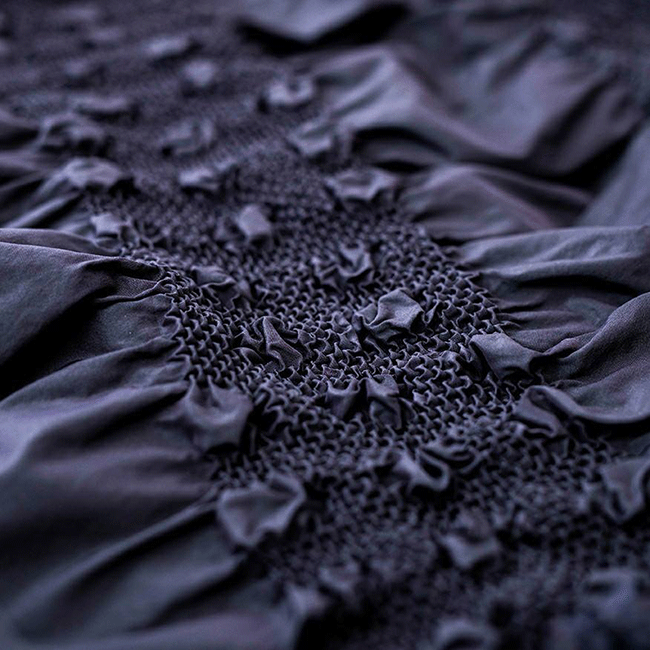The discovery of craft skills has the particularity of always arousing the curiosity and wonder of a local culture, climate, wisdom and techniques born in a more or less distant time. When Japanese textile know-how is exhibited in the J-Tex Showroom, the event attracts fashion professionals for a more pragmatic reason, however: the textile innovation born on Japanese lands rich in excellent craftsmanship turned towards the future.

For the past ten years, the Parisian event has attracted designers, fabric buyers and major French fashion houses to Square Edouard VII where, for four days (from 12 to 15 March this year), were exhibited the latest fabrics by sometimes century-old Japanese companies. This year, The Daily Couture shares three favorite innovations reflecting research focused on greener textiles and the latest innovation by a 151-year-old craft company.
Wooden yarn fabrics by Washino nuno, founded in 1962
This season, the newest innovation by Washino nuno, says Mr. Yutaka Ikeda, head of the J-Tex Showroom, is the “Mokuito” wooden yarn fabric, now suitable for textile manufacturing – five years after its first version. Made from Japanese cedar and cypress grown in Osaka, the fabric contains no harmful chemicals, I was told, unlike rayon. The weaving methods made it possible to display textiles for clothing, accessories, decoration and household linen. Far from being satisfied with a technical feat, namely overcoming the difficulty of making a paper yarn with a high enough strength to weave them, Washino nuno tried to make a fabric that best respected its natural environment. The company explains that it has succeeded in developing the complete cycle of fabric recycling: from raw material recovery to spinning. Thanks to departmental subsidies from the City of Osaka and the Government Forest Agency, wood chips are collected from trees that have been previously cut for the necessary maintenance of the forests, and originally considered as waste, I was told. The recovered wood chips are transformed into wood paper according to the traditional know-how of washi, then into wood yarns, to finally create a fabric made of wood yarns… Below, this video on the history of the company founded in 1962.
Recycled Fabrics by Toyota Tsusho Corporation, founded in 1926
Since its creation of automatic looms in 1926 by Sakichi Toyo, Toyota Industries Corporation has always maintained its link with the textile industry, which made its initial success. In 2018, the company showcases its expertise in recycled textiles on the French market with recycled nylons and polyester. The technicality of the elastic fabric combined with its lightness makes it an essential textile for sportswear design.
That Patagonia – probably one of the most beautiful brands in the world because of its pioneering, large-scale commitment to social, societal and environmental responsibility (see my interview with Shelly Gottschamer, Sportwear sourcing manager at Patagonia, after her Couture Experience with us) – uses Toyota Tsusho Corporation’s textile creations speaks volumes about the quality of the textiles created by the company in Osaka. In addition, let’s remind of one of its most acclaimed technical achievements : the world’s lightest taffeta, the “Transparent Aquatic Taffeta”. It is intended for “transparent clothing”…
From the know-how of kimono lining to the manufacture of fabrics with textured or reversible effects by the company Makita Shoten, founded 151 years ago


A beautiful story that continues with the 5th generation, and will continue with the following ones: two brothers and two sisters, three of whom work in the company of twenty people, nestled in the city of Yamanashi impregnated with a historically very strong textile industry. Among the new products on display are polyester and spandex fabrics with textured, almost pleated effects. And other reversible fabrics to meet the demands of fashion brands.
However, the company originally specialized in the purchase of fabrics for kimono liners whose art goes back to the Edo period. At the time, a rule ordered not to display clothes that were too luxurious, hence the appearance of linings with precious patterns made with very fine yarns. Later, the company applied its textile know-how to tailoring and then, to the manufacture of the umbrella, which remains, to this day, a crucial activity for the company. The double-sided woven – and not a double-sided iron-on fabric – comes from the know-how of the umbrella manufacturing process!
While textile manufacturing is slowing down in the region due to a lack of business succession and a drop in orders from the Japanese fashion industry, the company, which has remained a family business, wants to make itself known in the French fashion market. It has therefore decided to focus on high end design to meet the needs of fashion houses.Paris, capital of fashion? For many companies, this is obvious.







